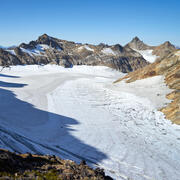Video Interviews about Glaciers
Video interviews about ongoing USGS glacier research were featured on the FOX Weather channel. The two videos feature Alaska Science Center scientist Louis Sass discussing retreating glaciers in Alaska and how glaciers have sculpted the landscape and examples of features created by glacial movement and erosion within the U.S.
The Alaska region has the largest area of glaciers outside of the Greenland and Antarctic Icesheets. Alaska's glaciers are shrinking faster than other glaciated regions. The U.S. Geological Survey is conducting research to understand the changes at both individual glacier and regional scales.
The USGS has a long history of glacier research. The Benchmark Glacier Project has been collecting data on five glaciers since the 1950s, specifically direct measurements of “surface mass balance.” Mass balance is a measure of a glacier's health. Think of these studies as the snow and ice accounting system for glaciers. Surface mass balance of a glacier is the difference between the snow accumulated in the winter and the snow and ice melted over the summer.
In addition to being strong indicators of global scale climate change, the loss of ice has profound implications for mountain ecosystems and linkages to aquatic and oceanic dynamics. Alaska’s coastal glaciers are among the most rapidly changing areas on the planet and glacier runoff can influence marine habitats, ocean currents and economic activities.
Video Interview on Wolverine Glacier: Measuring an Alaskan glacier
Video Interview: How ice transforms the landscape
Get Our News
These items are in the RSS feed format (Really Simple Syndication) based on categories such as topics, locations, and more. You can install and RSS reader browser extension, software, or use a third-party service to receive immediate news updates depending on the feed that you have added. If you click the feed links below, they may look strange because they are simply XML code. An RSS reader can easily read this code and push out a notification to you when something new is posted to our site.





